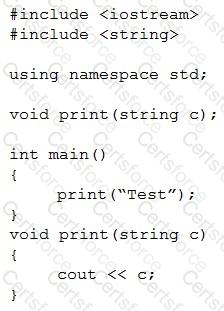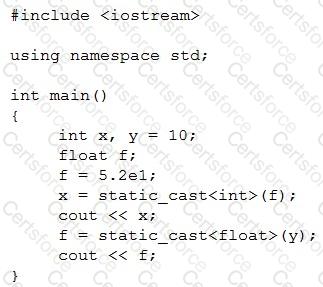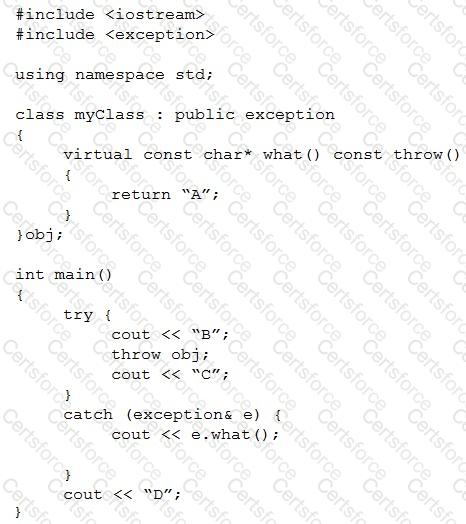What happens when you attempt to compile and run the following code?

What happens when you attempt to compile and run the following code?
#include
using namespace std;
int mul (int a, int b=2)
{
int r;
r=a*b;
return (r);
}
int main ()
{
cout << mul(1) << mul(2,4);
return 0;
}
What happens when you attempt to compile and run the following code?

What happens when you attempt to compile and run the following code?
#include
using namespace std;
namespace myNamespace1
{
int x = 5;
int y = 10;
}
namespace myNamespace2
{
float x = 3.14;
float y = 1.5;
}
int main () {
namespace newname = myNamespace1;
using namespace newname;
cout << x << " ";
cout << y;
return 0;
}
What happens when you attempt to compile and run the following code?
#include
#include
using namespace std;
struct Person {
string name;
int age;
};
class First
{
Person *person;
public:
First() {person = new Person;
person?>name = "John";
person?>age = 30;
}
void Print(){
cout<
}
};
int main()
{
First t;
t.Print();
}
What happens when you attempt to compile and run the following code?

What happens when you attempt to compile and run the following code?
#include
#include
using namespace std;
class A {
public:
int age;
A () { age=5; };
};
class B : private A {
string name;
public:
B () { name="Bob"; };
void Print() {
cout << name << age;
}
};
int main () {
B b,*ob;
ob = &b;
ob?>age = 10;
ob?>Print();
return 0;
}
What happens when you attempt to compile and run the following code?
#include
using namespace std;
int min(int a, int b);
int main()
{
int b=10;
b = min(5,20);
cout << b;
return 0;
}
int min(int a, int b)
{
if (a return(a); else return(b); }
What happens when you attempt to compile and run the following code?
#include
#include
using namespace std;
class A {
public:
A() { cout << "A no parameters";}
A(string s) { cout << "A string parameter";}
A(A &a) { cout << "A object A parameter";}
};
class B : public A {
public:
B() { cout << "B no parameters";}
B(string s) { cout << "B string parameter";}
};
int main () {
A a1;
A a2("Test");
B b1("Alan");
return 0;
}
Which code, inserted at line 19, generates the output "23"?
#include
#include
using namespace std;
class A {
int x;
protected:
int y;
public:
int z;
A() { x=1; y=2; z=3; }
};
class B : public A {
string z;
public:
int y;
void set() { y = 4; z = "John"; }
void Print() {
//insert code here
}
};
int main () {
B b;
b.set();
b.Print();
return 0;
}